Does Red's Of Jaffrey Service Propane Furnaces
At that place are different types of burn down extinguishers considering there are various types of fires. Each extinguisher is suitable for fighting certain types, and information technology's important for y'all to know the differences if it's your job to fight fires at piece of work. Being able to immediately distinguish which extinguisher you need in an emergency could brand a lifesaving difference.
Throughout this commodity, we will explain the different classes of fires, the symbols that place these, and the different types of extinguishers and their uses.
What Are the Different Classes of Fires?
Fires must be fought carefully depending on the materials involved. That is why they accept been classified in half dozen different categories:
- Grade A – Fires that involve solid flammables and dusts, such as wood, plastics, paper and cardboard, fabric and textiles, and dusts such equally grain dust and flour.
- Class B – Fires that involve flammable liquids, such as gasoline, petroleum oil, paint, or diesel.
- Course C – Fires that involve flammable gases, such every bit propane, butane, or methane.
- Class D – Fires that involve flammable metals including metal swarf, such as magnesium, lithium, sodium, potassium, titanium, or aluminium.
- Electric fires. Although it is not recognised equally a carve up grade of fire in Europe, electric fires that involve live equipment and electric sources are also a type y'all should behave in listen. Recollect of it as an informal Class Eastward.
- Class F – Fires that involve hot cooking oils and fats, such as vegetable oil, sunflower oil, olive oil, maize oil, lard, or butter (typically those used for deep-fat fryers).
All extinguishers volition take i or more of the following classes symbols, to indicate which course of fire they are suitable for.
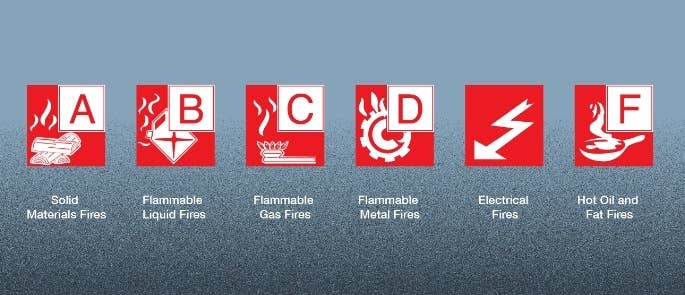
Each type of burn down extinguisher contains unlike materials that make them suitable for fighting certain types of fires, and is designed to safely and finer discharge its contents. The right one must be used for the right class of fire, otherwise they may prove ineffective or in fact worsen the situation.
For instance, using a water extinguisher on an electric burn or a carbon dioxide ane on a called-for oil fire is extremely dangerous.
What Are the Different Types of Fire Extinguishers?
In that location are five principal types of fire extinguishers:
- H2o.
- Powder.
- Foam.
- Carbon Dioxide (CO2).
- Wet chemical.
Each type is hands identifiable by their names, colours, and sometimes their hoses. Depending on their size, some may not come with a flexible hose, such as smaller foam or aqua water spray extinguishers.
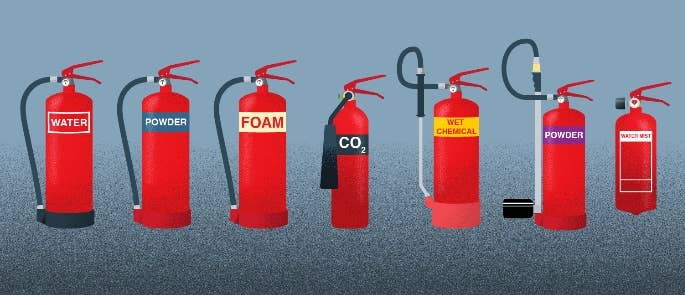
Let's take a expect at each type of fire extinguisher, their uses, and their risks beneath.
1. Water Extinguishers
There are two main types water extinguishers: standard water spray and dry out water mist.
Standard water extinguishers
These will be solid red and will have the discussion 'water' or 'aqua spray' printed across them in a indicate carmine band, often with a white border. They are your archetype model: they manipulate h2o at a high pressure to extinguish flames.
Water extinguishers are only suitable for class A fires, which means they can fight fires that involve wood, cardboard, newspaper, plastics, material and textiles, and other solid materials.
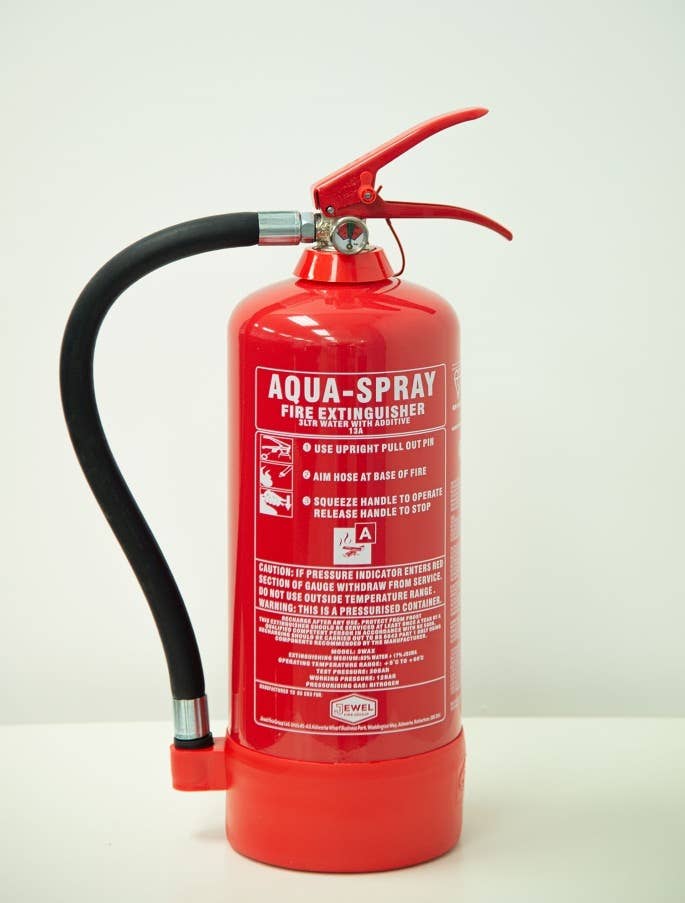
Warning: do not utilize h2o extinguishers on burning fat and oil fires and electrical appliances.
H2o extinguishers can sometimes contain chemical additives that improve their effectiveness by up to 300%. The chemicals remove the water's natural surface tension so that it soaks into burning materials more finer when used.
Dry water mist extinguisher
These types of burn down extinguishers will be solid red and will usually accept the words 'h2o mist' printed within a white rectangle.
Dry water mist extinguishers are unique in that many of them can combat near all types of fires, including grade F fires that are usually difficult to assault. The extinguisher's nozzle converts h2o into 'dry' microscopic particles, which are then fatigued into the fire and simultaneously cool and suffocate it to extinguish the flames.
They are also effective for fire-fighting because they class a condom barrier betwixt the user and the fire – which repels some of the heat – and exercise non get out difficult-to-make clean residue behind.
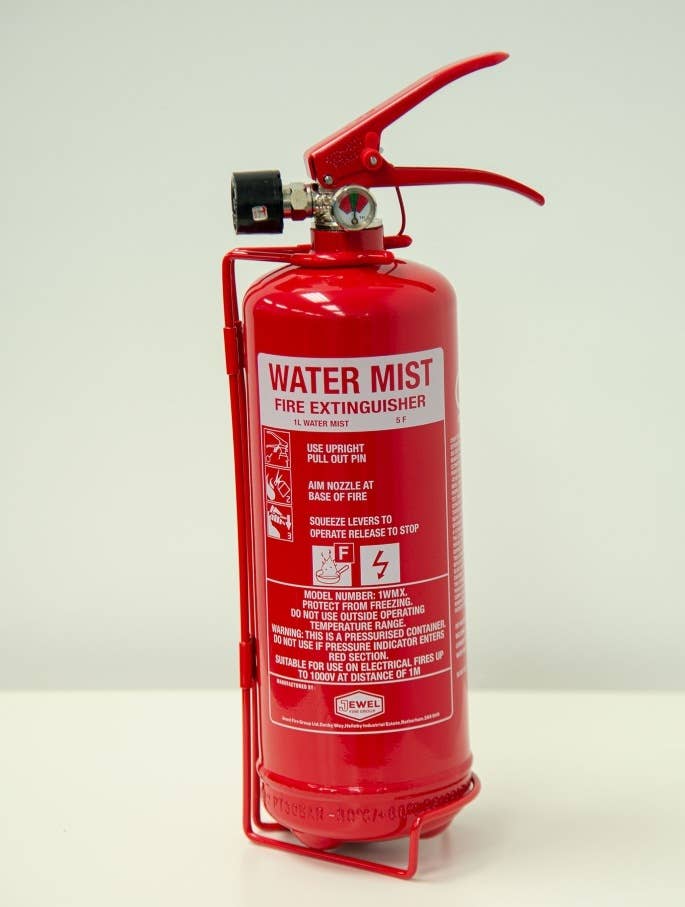
Alert: Although they are not currently classified as suitable for fighting class B (liquids) and C (gases) fires, dry out water mist extinguishers have been identified past fireservice.co.uk every bit effective against them.
Other types volition be better suited for fighting electrical fires, only dry mist extinguishers have normally had dielectrical tests carried out on them, which means that if they are accidentally used on electric fires, they will not pose equally significant a run a risk equally normal h2o extinguishers.
2. Powder Extinguishers
There are three types of powder extinguisher: ABC powder, M28 pulverization, and L2 powder.
ABC powder extinguisher
These types of extinguishers will say 'powder' in white text over a bluish rectangle, and underneath the rectangle will be written 'ABC powder'.
As their name suggests, these are designed to combat class A, B, and C fires – those involving solids, liquids, and gases. The powder acts as a thermal smash that cools the flames so called-for cannot continue. Due to their non-conductive nature, they are as well suitable for fighting electrical fires. However, they do non effectively penetrate the spaces in equipment hands, and then the fire could still re-ignite.
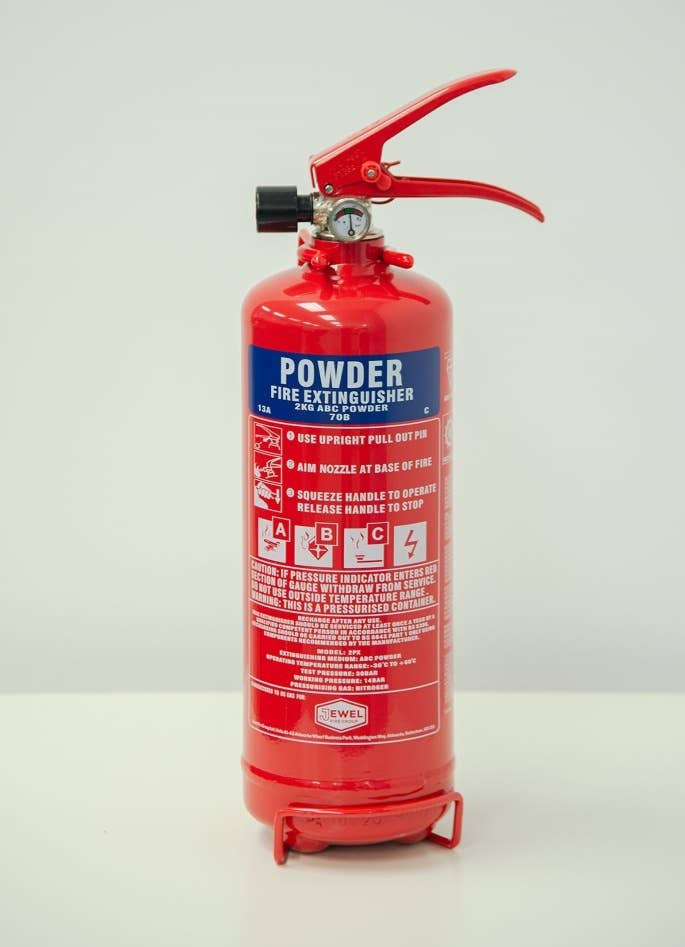
Warning: do not use on domestic chip or fat pan fires (class F).
The downside to ABC pulverisation extinguishers is that they pose a danger of inhalation when used in confined spaces, so they must not exist used in them. They besides get out balance behind that is difficult to clean upwards and causes harm to soft furnishings, carpets, and electrical equipment. This is why it'south brash you use a different type of extinguisher for fires involving electronics, such equally in an office with computers.
M28 and L2 powder extinguishers
These types of extinguishers are best identified by their unique hose, though they volition likewise say 'pulverisation' in white text in a signal violet rectangle. They are often referred to equally special pulverisation. Practice non misfile these with the ABC powder extinguishers, equally they are not designed for grade A, B, or C fires. They will state beneath the rectangle whether they are M28 or L2.
M28 and L2 are unique extinguishers in that they are designed for tackling Grade D fires – those involving combustible metals including swarf or powder, which are often produced in technology factories. Metals includes lithium, magnesium, sodium, or aluminium, for example.
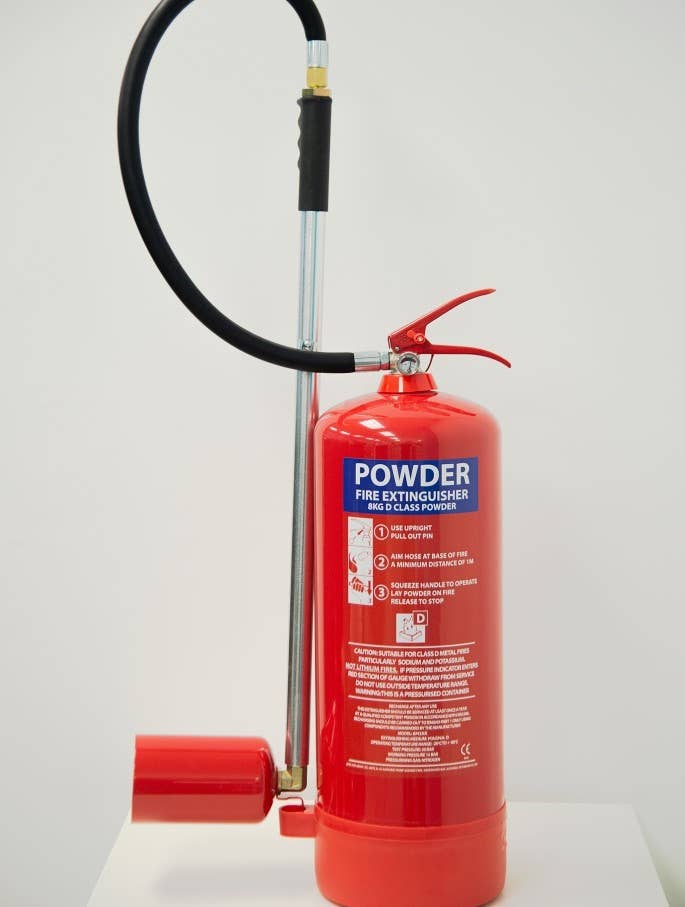
The extinguisher has a low velocity applicator to ensure that the M28 or L2 powder is applied gently and efficiently to called-for metal and to prevent the swarf from spreading. When sprayed, information technology forms a 'crust', which insulates the metal. This prevents the burn from spreading to other flammable materials and smothers the fire to prevent oxygen from reacting with the metal again.
L2 is suitable for all types of metal fires, whereas M28 cannot be used on lithium.
Warning: do not use on any other burn down type, specially live electric fires. Likewise, acquit in mind that water should non be allowed to come in to contact with burning metal.
3. Foam Extinguishers
Foam extinguishers are identifiable past the give-and-take 'cream' printed inside a cream rectangle on their bodies. They are primarily h2o based merely contain a foaming agent, which has rapid flame knock-down and a blanketing result. Information technology smothers the flames and seals vapours so that re-ignition cannot occur.
They are suitable for fighting class A and B fires.
When used confronting class A fires, the user can just bespeak and spray. Nonetheless, when used confronting form B fires – those with flammable liquids – they should not be sprayed directly into the liquid. This could cause the burn down to be pushed and spread to surrounding areas. The best method of application is to spray the foam nearby and so that it can build up and menstruation across it.
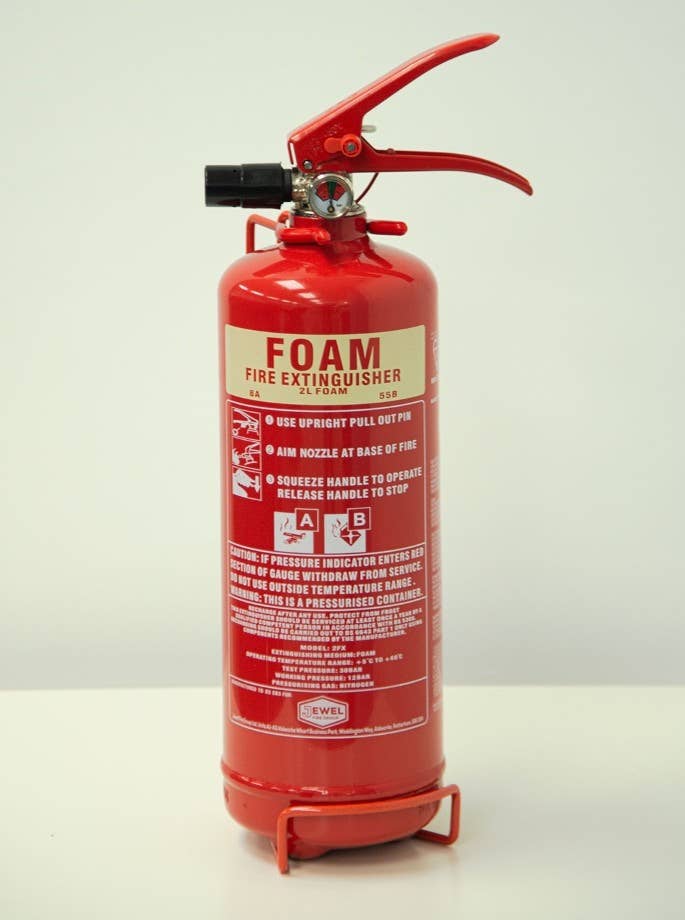
Alert: these should not exist used on any other fire classes, especially electrical fires or chip or fat pan fires. Many foam extinguishers will have had dielectrical tests performed on them, so foam is less hazardous than h2o if it is accidentally sprayed on alive electrical equipment. All the same, they should still not be used to fight electric fires as they are non specifically designed for them.
4. Carbon Dioxide (CO2) Extinguishers
These types of extinguishers can be identified by the text 'carbon dioxide' or 'COtwo' printed in white on a black rectangle. They also have a distinct type of hose.
Carbon dioxide extinguishers are used for combating grade B and electric fires – they suffocate the burn down by displacing oxygen in the air. Because they do non leave whatsoever substances behind and so minimise damage done to equipment, different other extinguishers, they are particularly useful for offices and workshops where electrical fires may occur.
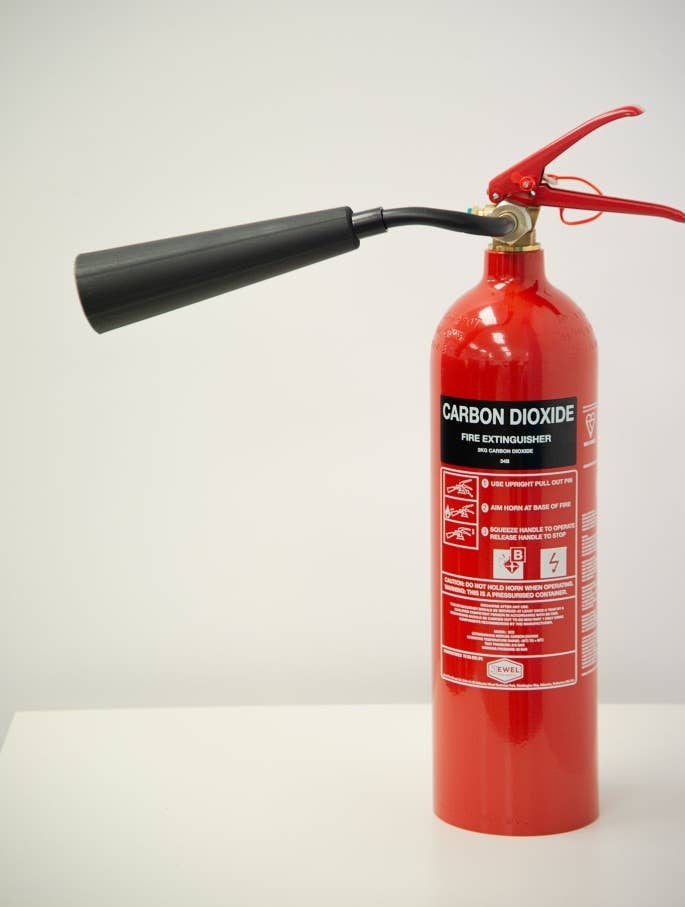
Alert: they must not be used on hot cooking oil and fat (class F) fires. The stiff jet from the extinguisher would button the burning oils or fats and spread the burn to surrounding areas. Also bear in heed that while carbon dioxide is effective at smothering fires, once the gas has floated away, the fire may reignite if the source has not been removed.
Furthermore: you must non hold the horn, base, or pipework on a COii extinguisher while operating information technology. The gas becomes extremely cold during its discharge and this could damage your hands.
5. Wet Chemic Extinguishers
These types of fire extinguishers are identifiable by the words 'wet chemic' printed across a yellow rectangle. It besides has an extended hose that you tin can hold and bespeak, which is useful when fighting fires on a kitchen top.
Wet chemic extinguishers are designed for combating fires that involve class F fires. They are effective because they are capable of stopping fires that are of an extremely high temperature, particularly cooking oils and fats. They also belch gently, stopping the burning oils and fats from being pushed and splashing to surrounding areas or even the user.
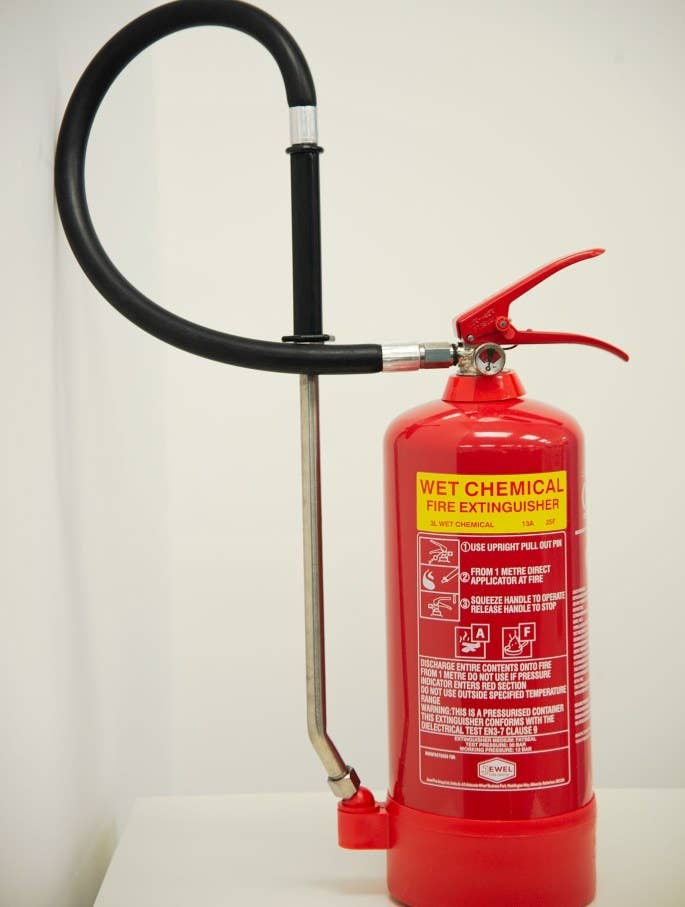
The chemicals contained inside the canister dispels the flames, cools the burning oil, and produces a lather-like solution that seals the surface and prevents re-ignition of the fire.
The best method of application is to spray in slow circular motions. The user should empty the entire contents onto the oils or fats. Otherwise, the fire may re-ignite.
Warning: wet chemical extinguishers are unremarkably non recommended for class B fires – those involving liquids. Likewise, although they are capable of combating class A fires, they are not every bit effective as other extinguishers at doing so.
Fire extinguishers are an important addition to fire safety measures, as they can help to stop small fires. Only it's important to remember that there are different types of fires, and choosing the first extinguisher you spot without knowing if its the right one could make the situation worse.
The information throughout this article has provided some key guidance on the dissimilar types of extinguishers and their uses, but go on in mind that you lot likewise need practical preparation to learn how to safely handle extinguishers.
Further Resources:
- Fire Safety Signs – A Guide to Safety Signage
- Fire Take chances Assessment for the Hospitality Manufacture
- Burn Condom Quiz
- Fire Prophylactic Awareness Preparation Course
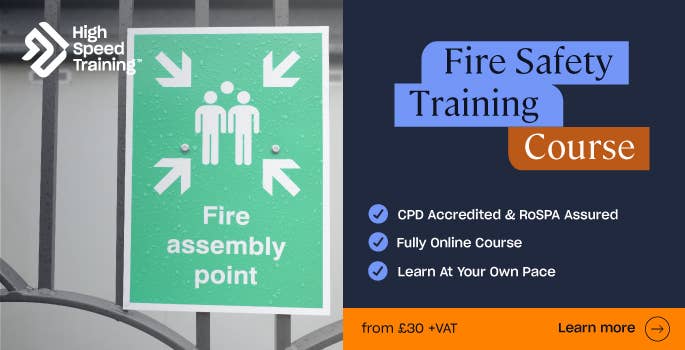
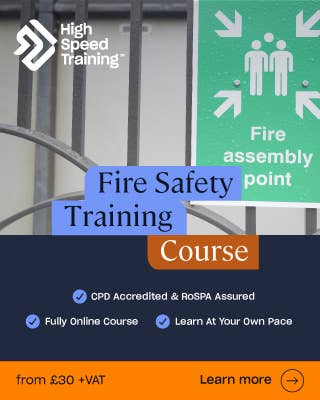
Source: https://www.highspeedtraining.co.uk/hub/different-types-of-fire-extinguishers/
Posted by: crusedowasobod.blogspot.com


0 Response to "Does Red's Of Jaffrey Service Propane Furnaces"
Post a Comment